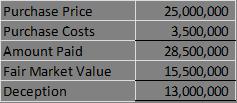Omissions of a Dangerous Mind
“Buyer’s remorse” occurs when a business bought is not the business the buyer expected. When this expectations gap is created by the seller’s deception, the buyer may recover the value of deception.
Deception may exist because the seller lied, exaggerated, or omitted to disclose material business facts. Discovering lies and exaggerations during a buyer’s business due diligence is typical. Discovering omissions is less typical, which is one reason why a buyer should require a seller to represent and warrant that no material business facts have been omitted. The value of deception may be quickly assessed by considering what impact the deception has on the purchase.
The deception may impact the purchase price formula. Such a formula typically includes some benefit stream of the target (i.e. earnings before interest, taxes, depreciation, and amortization “EBITDA”), a multiple applied to that benefit stream (i.e. 6 times EBITDA), and other items such as non-operating debt.
An EBITDA exaggeration of $750,000 and an omission of the existence of $3.5 million non-operating debt would reduce, say, a $25 million purchase price paid to $17 million a buyer would have paid but for the seller’s deception – a deception impact valued at $8 million as follows:

Alternatively, the deception’s impact could be so significant that the buyer would not have bought. The value of deception could then be (assuming so guided by law) the difference between the amount paid and the fair market value of the business at the purchase date. Because the amount paid necessary includes some purchase costs such as professional fees, the deception impact may be valued at $13 million as follows:

If your client is experiencing “buyer’s remorse” give us a call and let us do some quick math.
